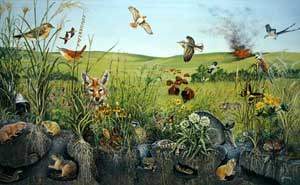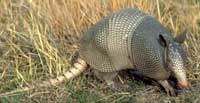Prairies and Lakes Wildlife


Prairies are home to many animals! Several of the animals that live in the Prairies and Lakes region are also our state symbols. For instance, the armadillo is the official Texas small mammal. The mockingbird is the official bird of Texas. Even the state dinosaur lived here! Other animals, such as wood ducks, have an inspiring story of survival.

The region is the present day home of the nine-banded armadillo, which is the only North American animal with “armor.” Hard, bony plates cover the animal for protection. The “bands” are actually joints in the armor, which allow the animal to curl up for more protection. Armadillos always have four babies at a time! The quadruplet babies develop from the same egg and are identical, all male or all female! Armadillos eat insects and dig burrows. They do not live where the soil is too hard to dig. Other animals use their abandoned burrows. Their armor protects these creatures from predators but automobiles can kill them easily. Dead armadillos are often seen on the side of the road because on hot summer days, armadillos are nocturnal, sometimes feed on the beetles and maggots on road kill and when frightened jump up. Although this jumping may scare away predators, it doesn't work on automobiles. The armadillo is the official state small mammal of Texas.

Mockingbirds are found in this region of Texas and just about every other habitat of the state. It is the official state bird! Male Mockingbirds sing constantly during mating season and are extremely territorial. They will attack other birds and animals that venture into their habitat area. Mockingbirds got their name because they “mimic” or mock other birds’ songs. If you hear a bird sing two, three or four different bird songs in a row, you are probably listening to a mockingbird. Females are attracted to male's song. They eat a lot of insects but also enjoy fruits and vegetables, so gardeners beware! When the Mockingbird was proposed as the state bird, it was stated that it is “a fighter for the protection of his home . . . like any true Texan . . .”

Wood Ducks are another common bird in the Prairies and Lakes Region although early in the 20th century they almost became extinct! Laws that regulated hunting and fees paid by hunters for management efforts helped restore these beautiful birds. The males are more colorful with green heads, red eyes, purple breasts, white throats, and bluish backs. They use old woodpecker holes or other “cavities” near water for their nests. Wood Duck babies are born with their eyes open, covered in down (soft baby feathers), and are able to find their own food. They have been known to jump 50 feet straight down from their nests to the ground safely! Building a nest over water makes for a softer landing when these babies leave their nests!
Tall, leafy cottonwood trees are wonderful shade trees that thrive in the moist soil along creeks and riverbanks in this region. These trees form small, greenish flowers in long clusters that droop down from its branches. Because they are greenish in color, they are not usually recognized as flowers, but they are! These droopy flowers are called “catkins.” Later, masses of wispy, cottony seeds are formed, hence the name Cottonwood! The cottonwood is part of the poplar family, and is called “Alamo” in Spanish.